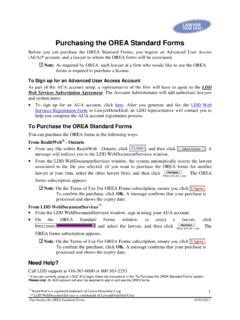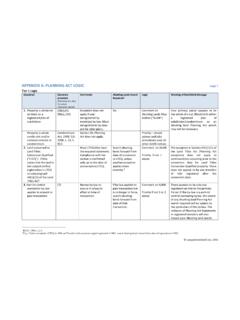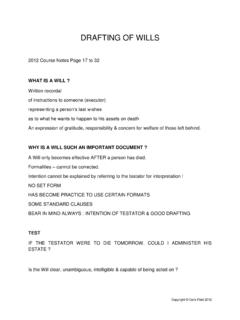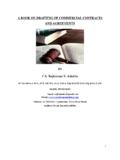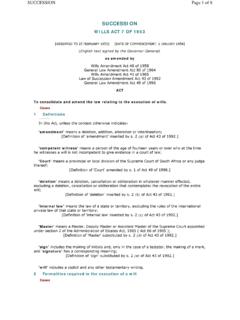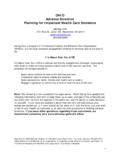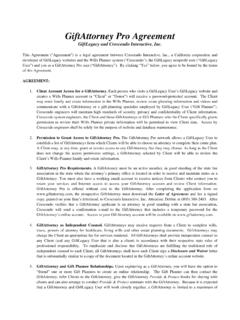Transcription of Explaining the Residue Function - LawyerDoneDeal
1 Explaining the Residue Function About Typical Residue Provisions The Residue of the estate is everything that is left over in the estate after debts, taxes, funeral expenses and other testamentary expenses, as well as any specific bequests or legacies, are paid. When drafting a Will, the concern is always to ensure that circumstances will not result in a situation which will give rise to an intestacy (a failure of the Will to apply to the facts as they are at the time of the testator's death). For example, consider the following typical scenario: A and B are married and they have one child, C.
2 The typical Residue provisions would provide that on the death of A and B then the Residue would be paid to C. (and this may be in trust but assume that we are dealing with an outright gift to C). However, if A, B and C die together (this is what is commonly referred to as a Family Disaster ), the Residue provisions need to address what happens in the event that C is not alive when both A and B die to prevent an intestacy. The Will should then set out that if C does not survive A and B for a period of thirty days (known as the Determination Date ), then the Residue will be paid to D, E and F.
3 This second layer of gift is payable on the Determination Date. This clause may seem like a technicality, but its omission is a source of negligence in drafting. About WillPowerWeb Templates The following eight WillPowerWeb templates are available: 1. Married Couple Residue Equally Distributed to Adult Children The Residue is paid to the surviving spouse, and on the death of the last of the spouses, as outright gifts to the adult children equally, with trust over provisions for minor grandchildren at specified ages. 2. Married Couple Residue Equally Distributed to Minor Children The Residue is paid to the surviving spouse, and on the death of the last of the spouses, in trust to the minor children at specified ages equally, with trust over provisions for minor grandchildren at specified ages.
4 3. Married Couple Residue Not Equally Distributed to Children The Residue is paid to the surviving spouse, and on the death of the last of the spouses, is distributed to only those children named in the Residue to Named Individuals tab according to the provisions specified in the clause selected specifically for each named child. WillPowerWeb is a registered trademark of LawyerDoneDeal Corp. 1. Explaining the Residue Function October 2008. 4. Married Couple Residue to Named Individuals - Where a couple has no children, the Residue is paid to the surviving spouse, and on the death of the last of the spouses, divided among any combination of family members, friends, charities or other non- profit organizations.
5 5. Single Person Residue Equally Distributed to Adult Children - The Residue is paid outright equally to the adult children, with trust over provisions for minor grandchildren at specified ages. 6. Single Person Residue Equally Distributed to Minor Children The Residue is paid in trust to minor children at specified ages equally, with trust provisions for minor grandchildren at specified ages. 7. Single Person Residue Not Equally Distributed to Children The Residue is distributed to only those children named in the Residue to Named Individuals tab according to the provisions specified in the clause selected specifically for each named child.
6 8. Single Person Residue to Named Individuals - The Residue is divided among any combination of family members, friends, charities or other non-profit organizations, with specific distributions to each named beneficiary. About Using Your Own Templates and Will Clauses You may also create your own Will templates and use your existing Will clauses. About the Residue Window The Residue window is divided into the following three tabs (sections): 1. Residue Equally to Children;. 2. Residue to Named Individuals; and 3. Family Disaster. Tip: Complete the Residue section using either Tab 1 Residue Equally to Children or Tab 2 Residue to Named Individuals, and then complete the Family Disaster section.
7 WillPowerWeb is a registered trademark of LawyerDoneDeal Corp. 2. Explaining the Residue Function October 2008. Tip: Before completing the information in these tabs, ensure you have included all of the individuals who may be entitled to receive the Residue in the People window. Note: The LDD templates automatically provide that the spouse, if there is one, will receive the Residue , where the spouse of the testator has been entered into the Client Info window. Therefore, spouses do not have to be added in the People window. WillPowerWeb is a registered trademark of LawyerDoneDeal Corp.
8 3. Explaining the Residue Function October 2008. 1. How to Complete Tab 1 Residue Equally to Children Note: Complete the fields on this window when using the following LDD templates, where the Residue is to be divided in equal portions among the children of the testator: Married Couple Residue Equally Distributed to Adult Children;. Married Couple Residue Equally Distributed to Minor Children;. Single Person Residue Equally Distributed to Adult Children; or Single Person Residue Equally to Minor Children. Note: Complete the fields on the Residue to Named Individuals window, if the Residue is to be divided in either equal or non equal portions to named individuals.
9 1. On the Residue Equally to Children window, enter the number of shares of the Residue that each beneficiary is to receive, or, if the Residue will be divided on a percentage basis, enter the percentage of the Residue to be given to each child. 2. From the drop-down list, select the Distribution Type. Tip: It is recommended that you select Fraction for the Distribution Type. LDD. clauses and templates are coded based on the selection of Fraction for the Distribution Type, and the following instructions presume that Fraction has been selected. If you use one of the other Distribution Types, make sure that you either enter your own clause precedent, or modify the LDD clauses.
10 Tip: It is not recommended that the percentage interest option be used imagine the difficulty in setting a percentage for three children. If you do select the percentage option, the total percentage must be 100%. 3. Enter the applicable fraction from the drop-down list or enter the fraction in the field. 4. Enter the age at which the children, if minors, are to receive the first fraction of the Residue . Enter the age at which the children are to subsequent fractions of the Residue . 5. In the Balance at Age section, complete the age when the children are to receive the final distribution of the Residue .

